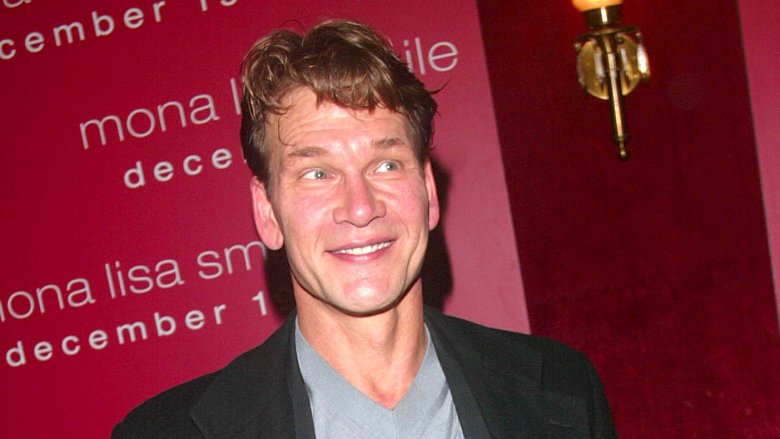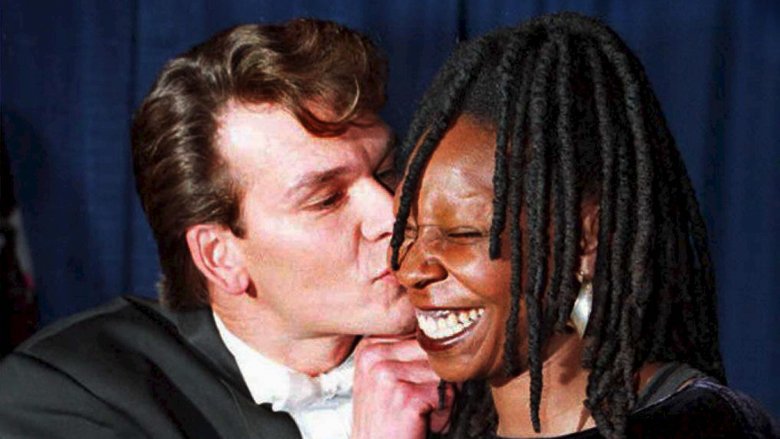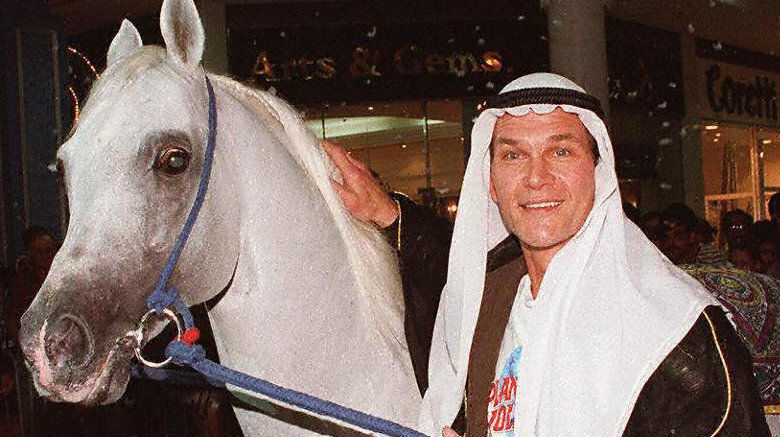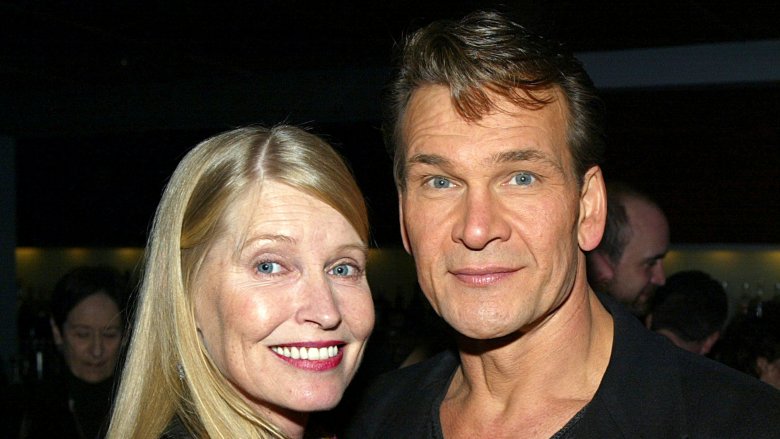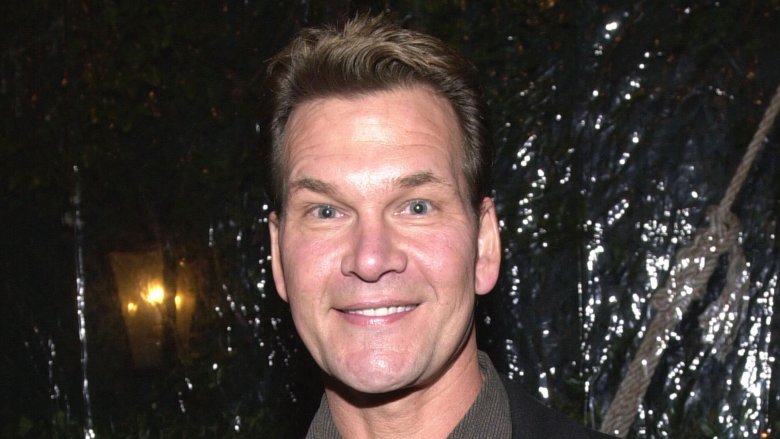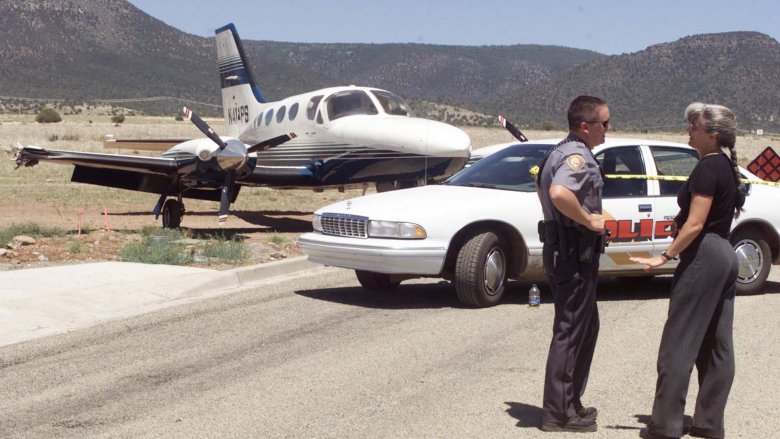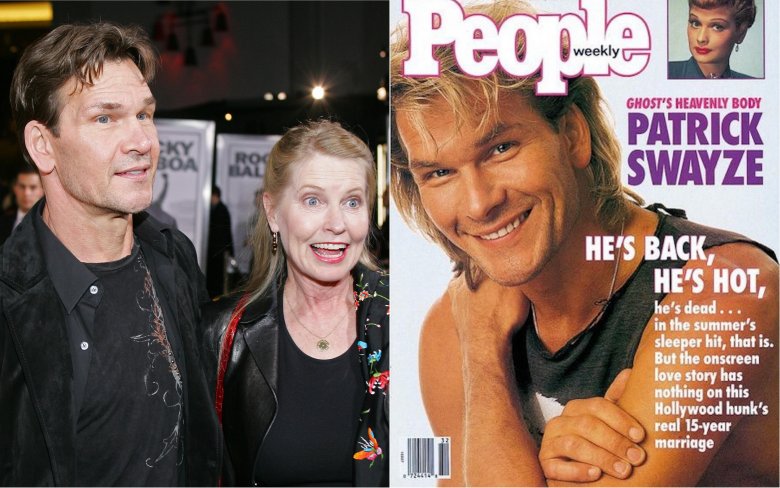The Untold Truth Of Patrick Swayze
In the 1980s and 1990s, Patrick Swayze established himself as one of Hollywood's most versatile, bankable, and loveable actors. The charming Texan could do it all. He led a teen rebellion against communist invaders in Red Dawn. Then he danced and romanced a repressed teen in the romantic drama Dirty Dancing. Swayze even played the most devoted and romantic ghost of all time in Ghost. It's hard to believe that he was the same actor who cracked skulls as the world's greatest bouncer in Road House and then portrayed the world's biggest creep in the cult classic Donnie Darko. (Oh, and in 1991, he was named the "Sexiest Man Alive" by People.)
Swayze shockingly and tragically died far too young in 2009 after a brief battle with pancreatic cancer, making him an eternally liked if somewhat mysterious Hollywood legend. Here's the untold truth of Patrick Swayze.
He really could dance, dirty and clean
Swayze's most beloved film is Dirty Dancing, in which he played cocksure dance instructor Johnny Castle, a role for which he'd accidentally prepared for most of his life. His dancing abilities in the film were no accident, nor the mere result of hours spent in training like some kind of reality show celebrity on Dancing with the Stars. No, Patrick Swayze had an extensive and impressive professional dance background.
His mother, Patsy Swayze, was a major figure in dance in Houston, where she was an instructor at the University of Houston as well as the founder and director of the Houston Jazz Ballet Company. Her students included iconic dance figures Tommy Tune, Debbie Allen, and John Travolta. The elder Swayze choreographed Travolta's 1980 movie Urban Cowboy, which prompted her to open a studio in Los Angeles. She also taught her son, of course. He later dropped out of San Jacinto College in Houston to tour as Prince Charming in Disney on Parade, then landed in New York to train at the famous Joffrey Ballet before he became a principal dancer with the Eliot Feld Ballet Company.
He wrote like the wind
The one thing perhaps even more popular in 1987 and 1988 than the movie Dirty Dancing was the soundtrack to Dirty Dancing. The album produced several top 40 hits, including the Oscar-winning "(I've Had) The Time of My Life" by Bill Medley and Jennifer Warnes; lite-rock staple "Hungry Eyes" by Eric Carmen; and the maudlin power ballad "She's Like the Wind," which made big-time movie star Patrick Swayze a one-hit wonder.
While the song was obviously a good fit for Dirty Dancing, Swayze actually wrote it years earlier for a forgotten 1984 movie called Grandview, U.S.A. He enlisted a friend, songwriter Bart Herbison, to help him because he'd heard the film's producers were looking for songs wherever they could find them. "Over the course of two or three days we hashed out the song," Herbison told The Tennessean. Two years later, Swayze played the demo for Dirty Dancing producers, who were looking for music on the cheap, because at that point the movie was going to be a low-budget, almost straight-to-video release." Dirty Dancing became a surprise hit, and so was "She's Like the Wind," which hit No. 3 on the pop chart in early 1988.
Swayze wrote songs for other movies, including "Cliff's Edge" for Road House, and "When You Dance" and "Finding My Way Back" for One Last Dance.
Patrick Swayze - rap icon
Not a lot of hunky, Houston-bred classically-trained dancers inspire much in the way of hip-hop culture, but somehow, Patrick Swayze did. Regardless of how his movies will age, he'll always have a second legacy as the inspiration for two wildly common slang expressions used in many rap songs.
Fortunately for Swayze, his last name rhymes with "crazy," and rhyming and talking about one's unhingedness are both vitally important to rap. In 1991, Kool G Rap spit a Road House reference on Marley Marl's "The Symphony Part II." It goes like this: "Reach for the pistol and you're crazy / try to blast and I'll be swinging that a** like Patrick Swayze." Nearly two decades later, Young Jeezy proclaimed in "And Then What" that he was "so crazy" but other rappers are phonies, merely "actors like Patrick Swayze."
But "Swayze" had meaning to rappers beyond its basic rhyme quality. In the 1990s, after the release of Ghost, "Swayze" came to be hip-hop shorthand for "gone." Take EPMD's 1992 tune "It's Going Down," which includes the line, "Now I'm Swayze, ghost, the rap host." Two years later, Notorious BIG said in 2Pac's "Runnin' (Dying to Live)" that after he shoots a guy, he'll "take his Glock and I'm Swayze."
Ghost almost ghosted him, and he almost ghosted Ghost
In Ghost, Swayze plays Sam Wheat, a finance dude so in love with his wife (Demi Moore) and making sexy pottery with her that after he's killed by street thugs, he hangs around as a ghost to watch over her. Swayze almost didn't get the role — director Jerry Zucker eliminated him from consideration very early in the production process, telling People that he didn't want to cast him after he "made the mistake of seeing some of his other movies."
But Swayze was a huge star, which landed him an audition ... that he crushed. When he read the movie's final scene, where Sam says goodbye, "We all had tears in our eyes, right there in the office," Zucker said. "I saw a side of Patrick that I never knew existed."
Despite the shaky ground that led to his casting, Swayze went to bat for another crucial cast member. Whoopi Goldberg provided comic relief as Oda Mae Brown, a phony psychic who Sam, a real ghost, uses to keep in contact with the human world. Goldberg wasn't the filmmakers' first choice, and she said on The View in 2008 that there was "resistance," claiming she landed the role because of Swayze's steadfast insistence.
"I'm not making this movie unless you put Whoopi Goldberg in there," Goldberg says Swayze told Zucker. The director took the package deal, and it all worked out, especially for Goldberg. "I won an Oscar because of Patrick Swayze."
His unexplained Hollywood hiatus
Swayze disappeared from movies for most of the late 1990s, but it wasn't because he was a persona non grata in Hollywood. In May 1997, Swayze was filming the indie movie Letters from a Killer in northern California, and while shooting a horseback scene, he fell off the animal and hit a tree. The actor was airlifted to a hospital where he was diagnosed with a broken leg — although Swayze's wife, Lisa Niemi, said in their 2009 joint memoir, The Time of My Life, that he broke both of his legs (devastating for a lifelong dancer) and suffered other "life-threatening injuries."
It took Swayze a long time to recover — so long that he was only able to act in one movie (the action thriller Black Dog) between the time of the accident and the turn of the century. His career didn't truly recover until 2001 and 2002, when he took a rare dramatic turn as a motivational speaker with a dark secret in Donnie Darko, followed by the role of a monster truck enthusiast in the comedy Waking Up in Reno.
Through thick and thin, he was a one-woman man
Among the most notable moments in Swayze's life in and around his mother's dance studio: He met the one and only love of his life there.
After he got off the road with Disney on Parade, the 20-year-old came back to Houston in 1972, returned to his mother's studio, and met a 16-year-old dance student named Lisa Niemi. That was it for Swayze. He fell in love with Niemi, and in 1975, they got married. The couple were wed for and incredible 34 years, up until Swayze's death in 2009.
Sure, they had their ups and downs as many long-married couple do. According to Woman Magazine, they split up for about a year in the early 2000s, when Swayze's lifelong battle with the bottle got out of hand. One morning while Swayze was asleep, Niemi left him and moved into an apartment 20 minutes away from their California ranch. They spoke every day and reunited on the set of 2004's King Solomon's Mines, ultimately securing the title of one Hollywood's longest-lasting love stories.
He battled the bottle for decades
In The Time of My Life (via Entertainment Weekly), Swayze opened up about his long battle to stay sober — and the bad stuff that happened to him when he couldn't.
After his father's death in the 1970s, Swayze admitted that he dealt with it by drinking what he called "copious amounts of alcohol" for the better part of a decade. When he landed what he thought would be a breakthrough role in the 1992 movie City of Joy, Swayze says he scaled his drinking habit back to almost nothing, but when the movie was a flop, he turned to booze again.
While filming Father Hood a year later, he was reportedly so hammered that the crew struggled to wake him up one day. It was on the set of that 1993 family comedy that Swayze says he experienced his "most embarrassing moment of all"— he passed out in the backseat of a car while filming a scene.
He checked into a rehab facility in Tucson, Ariz. after that, but still had relapses, including the one that nearly undid his marriage.
He almost crashed his private plane
In June 2000, Swayze flew his small, personal Cessna airplane from California to New Mexico. That was no big deal, except when he had to make an emergency landing. As he related in his memoir (via Entertainment Weekly), the plane had recently been serviced for some technical problems, but Swayze figured if he flew at a low altitude, he'd be fine. At one point, he put the aircraft on autopilot ... and woke up when the plane was just a few hundred feet off the ground and ready to crash. Radar records showed that while Swayze was passed out, he'd almost hit the ground 11 times — not to mention several near-misses with the many mountains on the flight path.
As it turns out, Swayze reportedly lost consciousness because there wasn't enough oxygen in the plane, a condition which could easily kill a person with lungs of steel, let alone Swayze, a three-pack-a-day smoker. However, when the news of Swayze's near-fatal mishap initially broke, the actor's confused, deoxygenated state led to rumors he almost crashed the plane because he was drunk — especially because there were reportedly empty beer cans in the plane. Four construction workers who witnessed the emergency landing were reportedly threatened with criminal charges for helping Swayze move and hide the alcohol that was on board.
Mere shorts could not contain him
Back before the widespread use of both digital video and the internet made accidental celebrity nudity — colloquially known as "wardrobe malfunctions" — instantly eternal, the occasional inadvertent movie star body part exposure was still just as salacious and controversial ... but a lot harder to share.
In the Aug. 6, 1990 issue of People, Swayze was the subject of a puff piece profile called "Ghost with the Most." Despite the many levels of oversight involved in producing an issue of a major magazine such as People that would prevent such a thing from happening, many readers insisted that they could see the tippy-top of Patrick Swayze's manhood peeking out from the top of his tight swim trunks in a dramatic photo of the actor diving into a swimming pool. Others suggested a far more likely story—that the rounded object was a looped drawstring creating the optical illusion of male genitalia. Nevertheless, even the promise of a huge movie star flashing wang made the issue quickly sell out.
Nobody puts Patrick in a corner
Maybe Dirty Dancing isn't the greatest movie, but it gave the world some indelible cinematic moments — that scene where Swayze's Johnny has to lift Jennifer Grey's Baby up high in the lake, for example, and when they successfully re-create the lift at the end of the movie in a proper ballroom setting to the strains of "(I've Had) The Time of My Life." Perhaps the most memorable moment in the movie is when Johnny, all macho bravado, steps right up to Baby's controlling father and ominously threatens, "Nobody puts Baby in a corner." Like any good movie catchphrase, it's equal parts awesome and cheesy. Initially, Swayze thought it was solidly the latter.
In The Time of My Life (via Indian Express), Swayze admitted that he hated that line. "I could hardly bring myself to say: 'Nobody puts Baby in a corner.' It sounded so corny." But, after seeing the final cut of Dirty Dancing, he "had to admit it worked." Swayze even adapted and adopted the line for personal, poignant, and heartbreaking use. When he was fighting for his life against pancreatic cancer, he'd tell people, "Nobody puts Patrick's pancreas in a corner."

